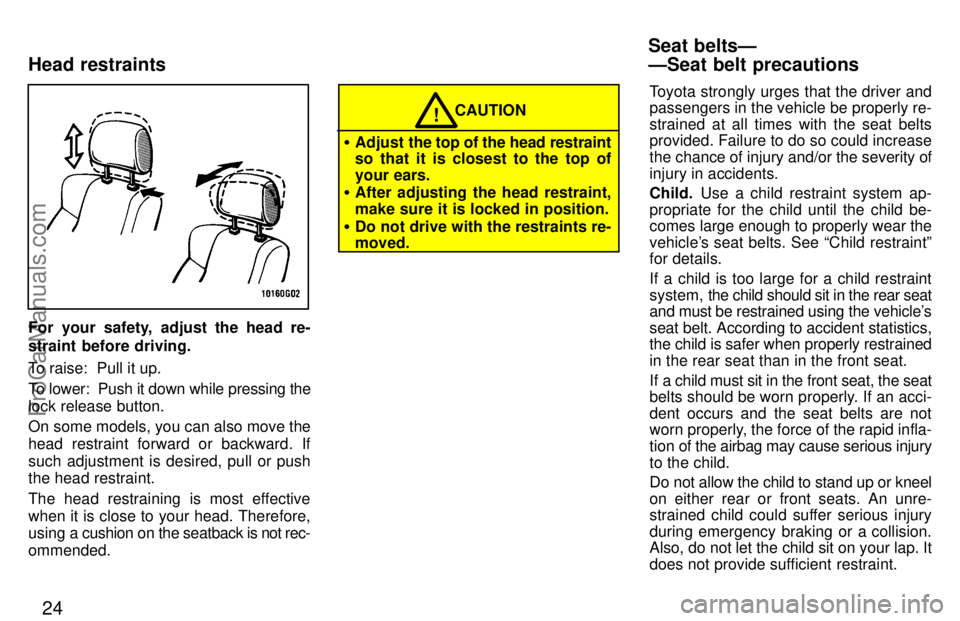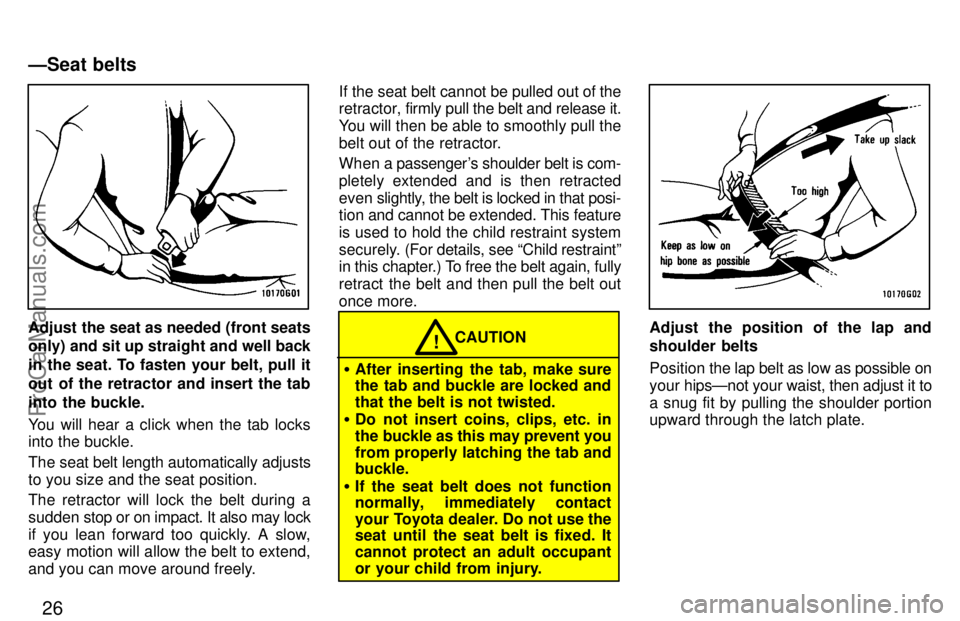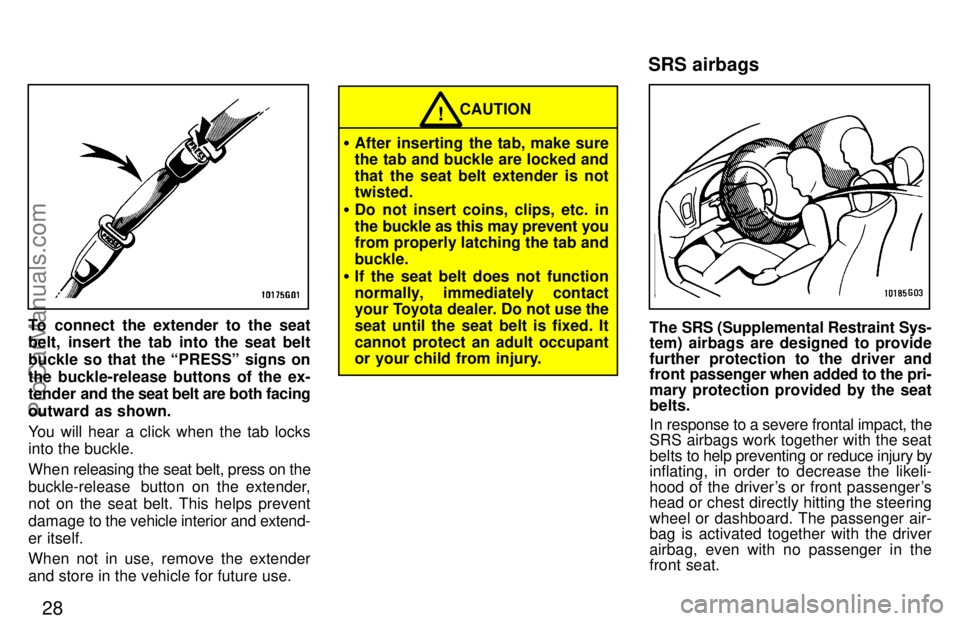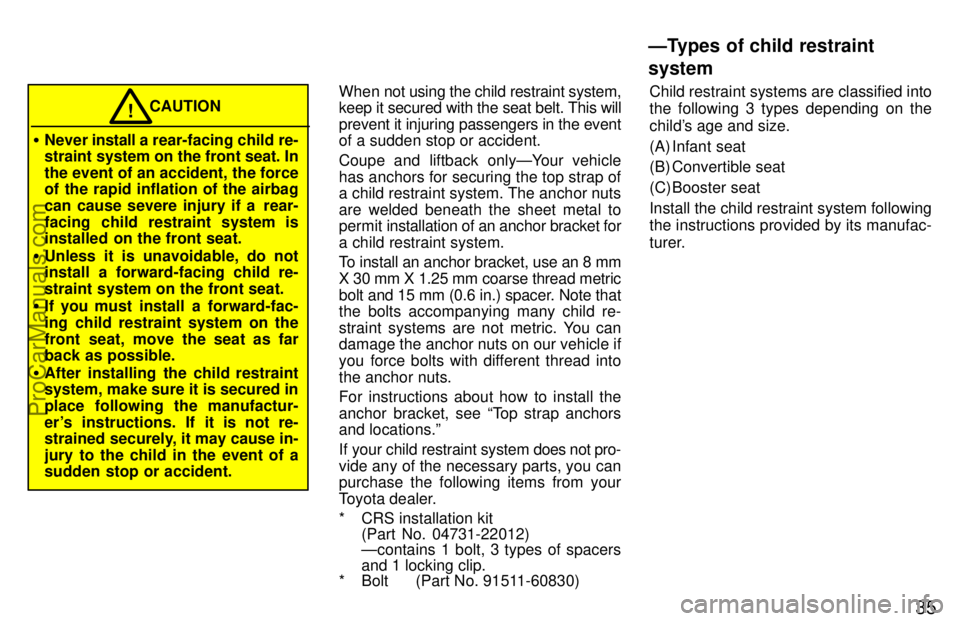Page 29 of 218

24
For your safety, adjust the head re-
straint before driving.
To raise: Pull it up.
To lower: Push it down while pressing the
lock release button.
On some models, you can also move the
head restraint forward or backward. If
such adjustment is desired, pull or push
the head restraint.
The head restraining is most effective
when it is close to your head. Therefore,
using a cushion on the seatback is not rec-
ommended.
CAUTION!
� Adjust the top of the head restraint
so that it is closest to the top of
your ears.
� After adjusting the head restraint,
make sure it is locked in position.
� Do not drive with the restraints re-
moved. Toyota strongly urges that the driver and
passengers in the vehicle be properly re-
strained at all times with the seat belts
provided. Failure to do so could increase
the chance of injury and/or the severity of
injury in accidents.
Child.
Use a child restraint system ap-
propriate for the child until the child be-
comes large enough to properly wear the
vehicle's seat belts. See Child restraintº
for details.
If a child is too large for a child restraint
system, the child should sit in the rear seat
and must be restrained using the vehicle's
seat belt. According to accident statistics,
the child is safer when properly restrained
in the rear seat than in the front seat.
If a child must sit in the front seat, the seat
belts should be worn properly. If an acci-
dent occurs and the seat belts are not
worn properly, the force of the rapid infla-
tion of the airbag may cause serious injury
to the child.
Do not allow the child to stand up or kneel
on either rear or front seats. An unre-
strained child could suffer serious injury
during emergency braking or a collision.
Also, do not let the child sit on your lap. It
does not provide sufficient restraint.
Head restraints Seat beltsÐ
ÐSeat belt precautions
ProCarManuals.com
Page 31 of 218

26
Adjust the seat as needed (front seats
only) and sit up straight and well back
in the seat. To fasten your belt, pull it
out of the retractor and insert the tab
into the buckle.
You will hear a click when the tab locks
into the buckle.
The seat belt length automatically adjusts
to you size and the seat position.
The retractor will lock the belt during a
sudden stop or on impact. It also may lock
if you lean forward too quickly. A slow,
easy motion will allow the belt to extend,
and you can move around freely. If the seat belt cannot be pulled out of the
retractor,
firmly pull the belt and release it.
You will then be able to smoothly pull the
belt out of the retractor.
When a passenger's shoulder belt is com-
pletely extended and is then retracted
even slightly, the belt is locked in that posi-
tion and cannot be extended. This feature
is used to hold the child restraint system
securely. (For details, see Child restraintº
in this chapter.) To free the belt again, fully
retract the belt and then pull the belt out
once more.CAUTION!
� After inserting the tab, make sure
the tab and buckle are locked and
that the belt is not twisted.
� Do not insert coins, clips, etc. in
the buckle as this may prevent you
from properly latching the tab and
buckle.
� If the seat belt does not function
normally, immediately contact
your Toyota dealer. Do not use the
seat until the seat belt is fixed. It
cannot protect an adult occupant
or your child from injury.
Adjust the position of the lap and
shoulder belts
Position the lap belt as low as possible on
your hipsÐnot your waist, then adjust it to
a snug fit by pulling the shoulder portion
upward through the latch plate.
ÐSeat belts
ProCarManuals.com
Page 33 of 218

28
To connect the extender to the seat
belt, insert the tab into the seat belt
buckle so that the PRESSº signs on
the buckle-release buttons of the ex-
tender and the seat belt are both facing
outward as shown.
You will hear a click when the tab locks
into the buckle.
When releasing the seat belt, press on the
buckle-release button on the extender,
not on the seat belt. This helps prevent
damage to the vehicle interior and extend-
er itself.
When not in use, remove the extender
and store in the vehicle for future use.
� After inserting the tab, make sure
the tab and buckle are locked and
that the seat belt extender is not
twisted.
� Do not insert coins, clips, etc. in
the buckle as this may prevent you
from properly latching the tab and
buckle.
� If the seat belt does not function
normally, immediately contact
your Toyota dealer. Do not use the
seat until the seat belt is fixed. It
cannot protect an adult occupant
or your child from injury.
CAUTION!
The SRS (Supplemental Restraint Sys-
tem) airbags are designed to provide
further protection to the driver and
front passenger when added to the pri-
mary protection provided by the seat
belts.
In response to a severe frontal impact, the
SRS airbags work together with the seat
belts to help preventing or reduce injury by
inflating, in order to decrease the likeli-
hood of the driver's or front passenger's
head or chest directly hitting the steering
wheel or dashboard. The passenger air-
bag is activated together with the driver
airbag, even with no passenger in the
front seat.
SRS airbags
ProCarManuals.com
Page 40 of 218

35
CAUTION!
�Never install a rea r-facing child re-
straint system on the front seat. In
the event of an accident, the force
of the rapid inflation of the airbag
can cause severe injury if a rear-
facing child restraint system is
installed on the front seat.
� Unless it is unavoidable, do not
install a forward-facing child re-
straint system on the front seat.
� If you must install a forward-fac-
ing child restraint system on the
front seat, move the seat as far
back as possible.
� After installing the child restraint
system, make sure it is secured in
place following the manufactur-
er's instructions. If it is not re-
strained securely, it may cause in-
jury to the child in the event of a
sudden stop or accident. When not using the child restraint system,
keep it secured with the seat belt. This
will
prevent it injuring passengers in the event
of a sudden stop or accident.
Coupe and liftback onlyÐYour vehicle
has anchors for securing the top strap of
a child restraint system. The anchor nuts
are welded beneath the sheet metal to
permit installation of an anchor bracket for
a child restraint system.
To install an anchor bracket, use an 8 mm
X 30 mm X 1.25 mm coarse thread metric
bolt and 15 mm (0.6 in.) spacer. Note that
the bolts accompanying many child re-
straint systems are not metric. You can
damage the anchor nuts on our vehicle if
you force bolts with different thread into
the anchor nuts.
For instructions about how to install the
anchor bracket, see Top strap anchors
and locations.º
If your child restraint system does not pro-
vide any of the necessary parts, you can
purchase the following items from your
Toyota dealer.
* CRS installation kit (Part No. 04731-22012)
Ðcontains 1 bolt, 3 types of spacers
and 1 locking clip.
* Bolt (Part No. 91511-60830) Child restraint systems are classified into
the following 3 types depending on the
child's age and size.
(A) Infant seat
(B) Convertible seat
(C) Booster seat
Install the child restraint system following
the instructions provided by its manufac-
turer.
ÐTypes of child restraint
system
ProCarManuals.com
Page 42 of 218
37
CAUTION!
�Never use rear-facing child re-
straint system in the front seat be-
cause the force of the rapid infla-
tion of the passenger airbag can
cause severe injury to the child.
�Do not use a rear-facing child re-
straint system in the rear seat if it
interferes with the lock mecha-
nism of the front seats. This can
cause severe injury to the child
and front passenger in case of
sudden braking or a collision.1. Run the lap and shoulder belt through
or around the infant seat following the in-
structions provided by its manufacturer
and insert the tab into the buckle taking
care not to twist the be lt. Keep the lap por-
tion of the belt tight.
ProCarManuals.com
Page 43 of 218
38
CAUTION!
�After inserting the tab, make sure
the tab and buckle are locked and
that the lap and shoulder portions
of the belt is not twisted.
� Do not insert coins, clips, etc. in
the buckle as this may prevent you
from properly latching the tab and
buckle.
� If the seat belt does not function
normally, it cannot protect your
child from injury. Contact your
Toyota dealer immediately. Do not
use the seat until the seat belt is
fixed.
2. Fully extend the shoulder belt to put it
in the lock mode. When the belt is then re-
tracted even slightly, it cannot be ex-
tended.
To hold the infant seat securely, make
sure the belt is in the lock mode before let-
ting the belt to retract.3. While pressing the infant seat firmly
against the seat cushion and seatback, let
the shoulder belt retract as far as it will go
to hold the infant seat securely.
ProCarManuals.com
Page 45 of 218
40
CAUTION!
�Never use a rear-facing child re-
straint system in the front seat be-
cause the force of the rapid infla-
tion of the passenger airbag can
cause severe injury to the child.
�Only when it is unavoidable
should a forward-facing child re-
straint system be used on the front
seat. Always move the seat as far
back as possible because the
force of deploying airbag would
cause serious injury to the child.� Do not use a rear-facing child re-
straint system in the rear seat if it
interferes with the lock mecha-
nism of the front seats. This may
cause severe injury to the child
and front passenger in case of
sudden braking or a collision.
ProCarManuals.com
Page 46 of 218
41
1. Run the lap and shoulder belt through
or around the convertible seat following
the instructions provided by its manufac-
turer and insert the tab into the buckle tak-
ing care not to twist the belt. Keep the lap
portion of the belt tight.
CAUTION!
� After inserting the tab, make sure
the tab and buckle are locked and
that the lap and shoulder portions
of the belt is not twisted.
� Do not insert coins, clips, etc. in
the buckle as this may prevent you
from properly latching the tab and
buckle.
� If the seat belt does not function
normally, it cannot protect your
child from injury. Contact your
Toyota dealer immediately. Do not
use the seat until the seat belt is
fixed.
2. Fully extend the shoulder belt to put it
in the lock mode. When the belt is then re-
tracted even slightly, it cannot be ex-
tended.
To hold the convertible seat securely,
make sure the belt is in the lock mode be-
fore letting the belt to retract.
ProCarManuals.com